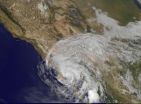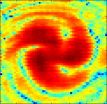(Press-News.org) Tropical Storm Odile continues to drench western Mexico and has now entered into the U.S. Southwest. On September 15, NASA's Terra satellite saw Odile's northernmost edge crossing the Mexican border into southern California. NOAA's GOES-East satellite on September 16 showed Odile's outer bands were already bringing storms to southern Arizona.
NASA Sees Odile Knocking on U.S. Border
On Sept. 15 at 2:35 p.m. EDT, the Moderate Resolution Imaging Spectroradiometer instrument aboard NASA's Terra satellite saw the northern fringes of Hurricane Odile straddling the border with southern California and Arizona. By the next day, September 16, NOAA's GOES-West satellite saw an outer band of the now weakened Tropical Storm Odile affecting Arizona.
Flood Watch in Effect for Tucson, Arizona and Surrounding Area
In the U.S., flash flood watch remains in effect from late tonight (Sept. 16) through Thursday afternoon including the greater Tucson area. The National Weather Service cautioned that the heaviest rainfall amounts will total 3 to 5 inches by late Thursday. For details visit: http://www.weather.gov.
Warnings in Effect in Mexico
A Tropical Storm Warning is in effect for the west coast of the Baja Peninsula from Puerto San Andresito to San Jose De Las Palomas and the east coast of the peninsula from Loreto to San Felipe. In addition, a Tropical Storm Warning is up for mainland Mexico From Huatabampito to Puerto Libertad. A Tropical Storm Watch is in effect for the west coast of the Baja Peninsula north of San Jose De Las Palomas to Cabo San Quintin.
Odile's Status on September 16
At 8 a.m. EDT on September 16, the center of Tropical Storm Odile was located near latitude 28.1 north and longitude 113.0 west. Odile was moving toward the north-northwest near 10 mph (17 kph) and a turn toward the north and north-northeast is expected later in the day. Maximum sustained winds have decreased to near 60 mph (95 kph) and weakening is forecast. The estimated minimum central pressure is 994 millibars.
The National Hurricane Center noted that on the forecast track, the center of Odile will continue to move over or near the east coast of the Baja California Peninsula through today...and move over the northern Gulf of California tonight and into northern mainland Mexico on Wednesday.
A visible image on Sept. 16 at 10:11 a.m. from NOAA's GOES-West satellite showed Tropical Storm Odile moving over Baja California, Mexico and stretching into the southwestern U.S.
Odile is likely to become a tropical depression by early Wednesday, September 17.
INFORMATION:
Text credit: Rob Gutro
NASA's Goddard Space Flight Center
NASA sees Tropical Storm Odile knocking at US Southwest
2014-09-16
ELSE PRESS RELEASES FROM THIS DATE:
Scientists twist radio beams to send data
2014-09-16
Building on previous research that twisted light to send data at unheard-of speeds, scientists at USC have developed a similar technique with radiowaves, reaching high speeds without some of the hassles that can go with optical systems.
The researchers, led by electrical engineering professor Alan Willner of the USC Viterbi School of Engineering, reached data transmission rates of 32 gigabits per second across 2.5 meters of free space in a basement lab at USC.
For reference, 32 gigabits per second is fast enough to transmit more than 10 hour-and-a-half-long HD movies ...
Kessler Foundation scientists link slowed processing speed with executive deficits in MS
2014-09-16
West Orange, NJ. September 16, 2014. Kessler Foundation researchers have published a study supporting the role of slowed processing speed in the executive deficits found in individuals with multiple sclerosis (MS). "Does slowed processing speed account for executive deficits in multiple sclerosis? Evidence from neuropsychological performance and structural neuroimaging," was published online ahead of print on August 18 by Rehabilitation Psychology The authors are Victoria Leavitt, PhD, of the Manhattan Memory Center, formerly of Kessler Foundation. Co-authors are Foundation ...
Tornadoes occurring earlier in 'Tornado Alley'
2014-09-16
WASHINGTON, D.C. – Peak tornado activity in the central and southern Great Plains of the United States is occurring up to two weeks earlier than it did half a century ago, according to a new study whose findings could help states in "Tornado Alley" better prepare for these violent storms.
Tornado records from Nebraska, Kansas, Oklahoma, and northern Texas – an area of high tornado activity dubbed "Tornado Alley" -- show that peak tornado activity is starting and ending earlier than it did 60 years ago.
Peak tornado activity, which occurs in the region from early ...
Water-based nuclear battery developed by MU can be used to generate electrical energy
2014-09-16
COLUMBIA, Mo. – From cell phones to cars and flashlights, batteries play an important role in everyday life. Scientists and technology companies constantly are seeking ways to improve battery life and efficiency. Now, for the first time using a water-based solution, researchers at the University of Missouri have created a long-lasting and more efficient nuclear battery that could be used for many applications such as a reliable energy source in automobiles and also in complicated applications such as space flight.
"Betavoltaics, a battery technology that generates power ...
Patients waiting too long to see doctor? Try 'just-in-time' management methods, researchers urge
2014-09-16
Using a pain clinic as a testing ground, researchers at Johns Hopkins have shown that a management process first popularized by Toyota in Japan can substantially reduce patient wait times and possibly improve the teaching of interns and residents.
In a report on the pilot study, published online Sept. 9, in Pain Medicine, the researchers adopted the so-called "Just-in-Time" training and inventory process used now by many manufacturers and service industries to stem waste and keep complicated operations from bottlenecking.
"We realized that a significant amount of time ...
Study on global carbon cycle may require reappraisal of climate events in Earth's history
2014-09-16
MIAMI – A recent study of the global carbon cycle offers a new perspective of Earth's climate records through time. Scientists at the University of Miami (UM) Rosenstiel School of Marine and Atmospheric Science suggest that one of the current methods for interpreting ancient changes in the concentration of carbon dioxide in the atmosphere and oceans may need to be re-evaluated.
The UM Rosenstiel School researchers measured the abundance of carbon-12 and carbon-13 isotopes in both the organic matter and carbonate sediments found in a nearly 700-meter marine sediment core ...
UCI team is first to capture motion of single molecule in real time
2014-09-16
Irvine, Calif., Sept. 16, 2014 – UC Irvine chemists have scored a scientific first: capturing moving images of a single molecule as it vibrates, or "breathes," and shifts from one quantum state to another.
The groundbreaking achievement, led by Ara Apkarian, professor of chemistry, and Eric Potma, associate professor of chemistry, opens a window into the strange realm of quantum mechanics – where nanoscopic bits of matter seemingly defy the logic of classical physics.
This could lead to a wide variety of important applications, including lightning-fast quantum computers ...
Making quantum dots glow brighter
2014-09-16
WASHINGTON, D.C., September 16, 2014 – Researchers from the University of Alabama in Huntsville and the University of Oklahoma have found a new way to control the properties of quantum dots, those tiny chunks of semiconductor material that glow different colors depending on their size. Quantum dots, which are so small they start to exhibit atom-like quantum properties, have a wide range of potential applications, from sensors, light-emitting diodes, and solar cells, to fluorescent tags for biomedical imaging and qubits in quantum computing.
A key property of quantum ...
Human faces are so variable because we evolved to look unique
2014-09-16
The amazing variety of human faces – far greater than that of most other animals – is the result of evolutionary pressure to make each of us unique and easily recognizable, according to a new study by University of California, Berkeley, scientists.
Our highly visual social interactions are almost certainly the driver of this evolutionary trend, said behavioral ecologist Michael J. Sheehan, a postdoctoral fellow in UC Berkeley's Museum of Vertebrate Zoology. Many animals use smell or vocalization to identify individuals, making distinctive facial features unimportant, ...
Gene variant that dramatically reduces 'bad' lipids
2014-09-16
Research using data collected from around 4,000 healthy people in the UK has enabled scientists to identify a rare genetic variant that dramatically reduces levels of certain types of lipids in the blood. The study is the first to emerge from the UK10K Project's cohort of samples from the general public and demonstrates the power of whole genome sequencing at scale.
"Until now it has only been possible to look for common variants of small effect in large genome wide association studies," says Dr Nicholas Timpson, first author from the Medical Research Council (MRC) Integrative ...








